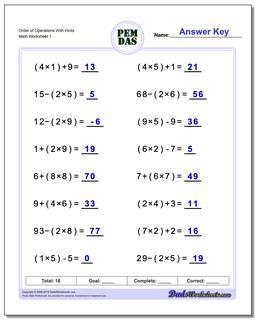Core Math Worksheets
Fraction Worksheets
Algebra
Other Worksheets
Place Value
Percentages
Rounding Numbers
Ordering Numbers
Standard, Expanded, Word Form
Mean Median Mode Range
Ratio Worksheets
Probability Worksheets
Roman Numerals
Factorization, GCD, LCM
Prime and Composite Numbers
Pre-Algebra
Geometry Worksheets
Blank Clocks
Telling Analog Time
Analog Elapsed Time
Greater Than and Less Than
Money
Arithmetic Sequences
Geometric Sequences
Venn Diagram
Graph Worksheets
Measurement & Conversions
Patterns and Puzzles
Color by Number
Holiday & Seasonal
Early Learning
Printables
Calculators
Math Worksheets by Grade
Worksheet News
Order of Operations Worksheets
The printable order of operations worksheets below will get you mastering your PEMDAS skills in no time! They start with simple problems that deal only with the order of operations problems related to the basic addition, subtraction, multiplication and division rules, but later worksheets deal with order of operations involving all of the PEMDAS rules. If you work through these worksheets, your students will have complete mastery of order of operations and be ready for harder algebra equations where order of operations mastery is a necessity!
Order of Operations
24 Order of Operations Worksheets
These order of operations worksheets mix basic arithmetic, including parentheses and exponents, and tests students understanding of PEMDAS. If you are looking for order of operations worksheets that test your knowledge of the PEMDAS rules, these math worksheets are a good start. You can also find order of operations worksheets with negative numbers and order of operations worksheets with comparisons on those other worksheet pages of the site.
Order of OperationsOrder of Operations (PEMDAS)
The order of operations are set of conventions used in math to decide what order operations need to be evaluated in to consistently get to the answer to a problem. These are also called precedence rules, and the occur in math problems as well as computer programming languages. Students make errors related to order of operations because we train them to read left-to-right, and a natural tendency is simply to evaluate a math program the same way. Left-to-right processing of a mathematical expression is the short road to whatever you get when you divide by zero. Just call it bad.
Instead, check with dear Aunt Sally. PEMDAS is a mnemonic tool used to help remember what operations to perform in what order. PEMDAS stands for Parentheses, Exponents, Multiplication, Division, Addition, Subtraction. We can remember this ordering with the phrase, 'Please excuse my dear Aunt Sally.' By remembering this phrase, we know the order to evaluate terms in an expression. Anything inside parentheses is always evaluated first, even if it contains operations that are of lower precedence. Always work from the 'inside out' when dealing with expressions that have parentheses. Within a set of parathenses, the same rules for order of operations apply, so look for other parenthees and similarly follow all the other rules below.Next, consider any terms that have exponents. The exponent is something that you might consider strongly attached to a term in an expression, much like a sign on a number. Following this, consider any multiplication or division operations. These operations are of equal precedence, so they can be evaluated in any order themselves. The same is true of the next set of operations, addition and subtraction. They can be evaluated in any order as long as you've done all of the preceding operations completely.
Order of operations problems are typically introduced around 5th grade or 6th grade, depending on student ability. Practice with these PEMDAS worksheets will help kids prepare for algebra and other more complex math subjects that come along with middle school grades.
The order of operations worksheets in this section provide plenty of practice, and they gradually introduce each step in the PEMDAS mnemonic. If you work your way through all of them, you'll be an order of operations expert in no time. Aunt Sally would be proud.

